We celebrate Saints Peter and Paul for their unwavering faith, selflessness, and tireless dedication to spreading the Good News of the Gospel. The legacies of Saints Peter and Paul continue to inspire and guide millions of Catholics around the world to this day.
As we explore the lives of Saints Peter and Paul in this blog post, we will discover the deep spiritual significance of their contributions to the Church, as well as the ways in which their examples can inspire us to live lives of greater faith, service, and holiness. So sit back, relax, and let us embark on this journey together, as we delve into the rich and inspiring lives of Saints Peter and Paul.
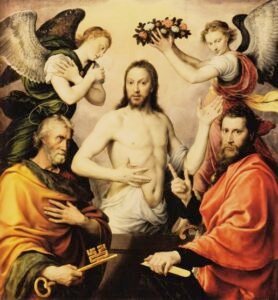
What are Saints Peter and Paul known for?
When I discovered the beautiful symmetry of Saints Peter and Paul in Rome and how redeeming they are to our Christian faith, I was blown away.
I love how God is the ultimate author and he picks up on every little detail to make the story that much better.
During the time of Christ and Rome was considered the greatest civilization. They had been founded by two twins, Romulus and Remus, whos statues of them suckling a wolf can still be seen frequently in statue carvings all around the city.
Today, Rome has been overtaken by love. Overtaken by salvation and it’s not Romulus and Remus that are the founders of this new and beautiful turnover of the city, it’s Saints Peter and Paul.
First, let’s start with a brief overview of Saints Peter and Paul’s achievements and legacy. Saints Peter and Paul were two of the twelve apostles chosen by Jesus Christ to spread his message and build his Church. Peter, a Galilean fisherman who also went by the names Simon and Cephas, rose to prominence as the first bishop of Rome and the figurehead of the early Christian movement.
Formerly known as Saul, Paul was a Jewish Pharisee who persecuted Christians until he had a conversion experience on the way to Damascus. Paul then traveled extensively throughout the Mediterranean world, preaching and writing letters to various churches, and is often considered the greatest missionary and theologian of the early Church.
Saints Peter and Paul are also celebrated for their martyrdom, which occurred around the same time in Rome, under the reign of Emperor Nero, who blamed the Christians for a fire that destroyed much of the city. Peter was crucified upside down, as he reportedly did not feel worthy to die in the same way as Jesus, while Paul was beheaded, as he was a Roman citizen and therefore not subject to crucifixion. Their deaths cemented their status as heroes of the faith, and their relics and tombs became important pilgrimage sites.
In art and literature, Saints Peter and Paul are often depicted together, symbolizing the unity and diversity of the Church. Peter is typically portrayed with keys, as Jesus gave him the keys of the Kingdom of Heaven and declared him the rock upon which he would build his Church. Paul is usually shown with a sword, as he wrote about the spiritual warfare against evil and the importance of the Word of God as a weapon. Together, Saints Peter and Paul embody the two complementary aspects of Christian discipleship: faith and works, grace and truth, humility and boldness.
What is the story of Peter and Paul?
Now, let’s dive deeper into the story of Saints Peter and Paul, tracing their paths from their humble beginnings to their glorious endings.
Peter was born in Bethsaida, a fishing village on the Sea of Galilee, and was originally named Simon. He had a brother named Andrew, who introduced him to Jesus. Peter was initially skeptical of Jesus, but after witnessing some of his miracles and hearing his teachings, he declared, “You are the Christ, the Son of the living God” (Matthew 16:16). Jesus then renamed him Peter, which means “rock,” and promised to build his Church upon him.
Peter became one of Jesus’ closest disciples, along with James and John, and witnessed some of the most dramatic events in his life, such as the Transfiguration, the raising of Jairus’ daughter, and the agony in the Garden of Gethsemane. Peter also made some of the most famous mistakes, such as denying Jesus three times during his trial and rebuking him for predicting his own death. However, after Jesus’ resurrection, Peter was forgiven and commissioned to feed his sheep, as a sign of his love and leadership.
Peter then became a key figure in the early Church, preaching to Jews and Gentiles alike and performing miracles such as healing the lame man at the Beautiful Gate of the Temple. He also faced opposition and persecution, including imprisonment and flogging, but remained steadfast in his faith and courage. In one of the most dramatic episodes of his life, Peter was miraculously freed from prison by an angel, which inspired
Why are Saints Peter and Paul together?
If you have ever seen a painting, sculpture, or stained-glass window depicting the apostles, chances are that Saints Peter and Paul are standing side by side, often with distinctive attributes such as keys and a sword. But why? What is the connection between these two men, who had such different backgrounds and personalities?
One possible answer is that Saints Peter and Paul embodied the two main streams of Christianity: Jewish and Gentile. Peter was a Galilean fisherman who grew up in a Jewish tradition and initially focused on preaching to his fellow Jews, while Paul was a Pharisee who had a Roman citizenship and a cosmopolitan outlook, and specialized in evangelizing the Gentiles. Together, Saints Peter and Paul represented the unity and diversity of the Church, which was meant to include people from all nations and cultures.
Another reason for their pairing is that Saints Peter and Paul had a complex and complementary relationship, which was not always harmonious but ultimately fruitful. Peter was the leader of the apostles, the first among equals, and the one who received the revelation of Jesus’ identity as the Son of God. Paul, on the other hand, was a latecomer to the apostolic band, and initially clashed with Peter over issues such as circumcision and table fellowship.
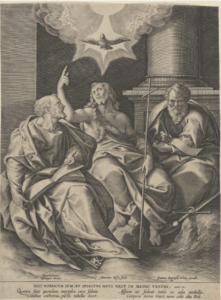
However, after a dramatic encounter in Jerusalem, where they reconciled and recognized each other’s mission, Saints Peter and Paul became close collaborators and mutual supporters. Paul described his visit to Jerusalem in his letter to the Galatians:
“[I] went up to Jerusalem to see Peter, and remained with him fifteen days. But I saw none of the other apostles except James the Lord’s brother… Then after three years I went up to Jerusalem to visit Cephas and remained with him fifteen days. But I saw none of the other apostles except James the Lord’s brother” (Galatians 1:18-19; 2:1-2).
Saints Peter and Paul also shared a fate: martyrdom in Rome under the persecution of Emperor Nero. Although they died in different ways (Peter was crucified upside down, while Paul was beheaded), they both gave their lives for the sake of the Gospel and the Church. Their martyrdom cemented their status as heroes of the faith and inspired countless believers to follow their example of courage and devotion.
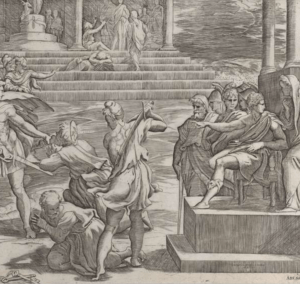
Why did Jesus change Peter’s name?
The Gospel of John provides the most detailed account of this episode, which took place shortly after Jesus had met Peter for the first time, and his brother Andrew had brought him to Jesus:
“[Jesus] looked at him and said, ‘You are Simon son of John. You will be called Cephas’ (which, when translated, is Peter)” (John 1:42).
The name Simon was a common Jewish name, meaning “he who hears,” while Cephas was an Aramaic name, meaning “rock.” Jesus may have chosen this name because he saw in Peter a future leader of the Church, who would provide stability and strength to the other believers. The name change also signaled a new identity and a new mission for Peter, who had previously been a fisherman, but was now called to be a “fisher of men” (Matthew 4:19).
Through this name change, Jesus was also giving Peter a new identity. He was transforming him from an ordinary fisherman into a leader of the Church, with a specific purpose and mission. Peter’s new name was a symbol of his new identity and role in the world.
Jesus changed Simon’s name to Peter as a way of recognizing his potential and preparing him for his future role in the Church. This act of renaming was a significant moment in Peter’s life, marking a new beginning and a new sense of purpose. It was a clear sign of Jesus’ love and confidence in him, and it continues to inspire and guide believers to this day.
Why was St. Peter given the keys to heaven?
The story of the keys to heaven begins with one of the most famous and controversial passages in the New Testament: Matthew 16:13-20. In this scene, Jesus and his disciples are in the region of Caesarea Philippi, and Jesus asks them a crucial question: “Who do people say the Son of Man is?” (Matthew 16:13). The disciples reply with various opinions, such as John the Baptist, Elijah, or one of the prophets. Then, Jesus turns the question to them: “But what about you?” he asks. “Who do you say I am?” (Matthew 16:15).
Peter, always eager to speak up, gives the answer that has echoed through the centuries: “You are the Messiah, the Son of the living God” (Matthew 16:16). Jesus commends Peter for his insight, and then makes a remarkable statement:
“Blessed are you, Simon son of Jonah, for this was not revealed to you by flesh and blood, but by my Father in heaven. And I tell you that you are Peter, and on this rock I will build my church, and the gates of Hades will not overcome it. I will give you the keys of the kingdom of heaven; whatever you bind on earth will be bound in heaven, and whatever you loose on earth will be loosed in heaven” (Matthew 16:17-19).
There are several layers of meaning in this passage, which has been interpreted in different ways by various Christian traditions. However, one common understanding is that Jesus was designating Peter as the leader and foundation of the Church, and entrusting him with the authority to govern and guide the believers. The “rock” on which Jesus would build his Church could refer to Peter’s faith, his confession of Jesus’ identity, or even his person as a whole.
The keys of the kingdom of heaven symbolize the power to admit or exclude people from the community of believers, and to pronounce judgments on moral or doctrinal issues. The binding and loosing language echoes the rabbinic language of declaring things forbidden or permitted, and suggests that Peter and the Church would have a role in discerning God’s will and enforcing it.
What did Peter see in heaven?
Now, let’s shift our focus to another fascinating aspect of Peter’s legacy: his glimpse of heaven. In the book of Acts, we read about an episode where Peter had a vision that challenged his assumptions and expanded his horizons. The context was the mission to the Gentiles, which was a controversial and divisive issue among the early Christians.
Peter was in Joppa, staying at the house of Simon the tanner, when he went up to the roof to pray. While he was there, he fell into a trance and saw a vision of a sheet coming down from heaven, containing all kinds of animals, both clean and unclean according to Jewish dietary laws. A voice told him to “Get up, Peter. Kill and eat” (Acts 10:13). Peter was hesitant, since he had never eaten anything unclean, but the voice repeated the command three times. Then, the sheet was taken up to heaven again.
Peter was puzzled and perplexed by this vision, but soon received an unexpected visit from messengers sent by a Roman centurion named Cornelius….
What did Jesus mean when he told Peter “upon this rock I will build my church”?
To answer this question, we need to look at the context and the language of the passage. As we saw in our previous post, this statement was made in response to Peter’s confession of faith in Jesus as the Messiah and the Son of God. Jesus commended Peter for his insight, and then proceeded to declare a series of promises and commissions to him.
The key phrase, “upon this rock I will build my church,” has been the subject of much debate and speculation over the centuries. Some have claimed that Jesus was referring to Peter himself, as the foundation and leader of the Church. Others have argued that Jesus was referring to Peter’s faith or his confession of Jesus’ identity, as the true rock on which the Church would be built. Still others have suggested that Jesus was using a pun or wordplay, since Peter’s name means “rock” in Aramaic, and the Greek word for “rock” (petra) is feminine, while Peter is male.
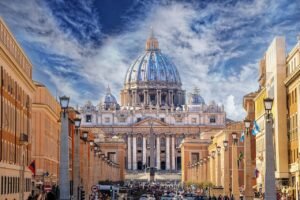
Regardless of the exact meaning, it is clear that Jesus was entrusting Peter with a crucial role in the formation and governance of the Church. The promise that “the gates of Hades will not overcome it” suggests that the Church would face opposition and persecution, but would ultimately prevail against the powers of death and evil. The authority to “bind and loose” on earth and in heaven implies that Peter and the apostles would have the power to declare and enforce divine laws and judgments, under the guidance of the Holy Spirit.
Which saint denied Jesus three times before he died?
Now, let’s turn to another aspect of Peter’s story that is often mentioned in connection with his leadership of the Church: his denial of Jesus. According to the Gospel accounts, Peter was one of the closest and most loyal disciples of Jesus, but also one of the most impulsive and outspoken. When Jesus was arrested and taken to the high priest’s house for a trial, Peter followed him at a distance and entered the courtyard, where he was recognized as one of Jesus’ followers.
Three times, different people asked Peter if he was one of Jesus’ disciples, and three times, Peter denied it. The first time, he said, “Woman, I don’t know him” (Luke 22:57). The second time, he said, “Man, I am not” (Matthew 26:72). The third time, he even swore and cursed, saying, “I don’t know the man!” (Matthew 26:74). Immediately after the third denial, the rooster crowed, and Peter remembered Jesus’ prediction that he would deny him three times before the rooster crowed.
Peter’s denial of Jesus is often seen as a symbol of human weakness and the dangers of overconfidence. Despite his earlier claims of loyalty and courage, Peter faltered when faced with the threat of arrest and persecution. However, his repentance and restoration by Jesus after the resurrection demonstrate the power of forgiveness and reconciliation. Peter went on to become a key figure in the early Church, preaching the gospel and performing miracles, and ultimately facing martyrdom for his faith.
Did Jesus forgive St. Peter?
As we saw in our previous post, Peter denied Jesus three times before the rooster crowed, as Jesus had predicted. This was a moment of weakness and fear for Peter, who had earlier proclaimed his loyalty and devotion to Jesus. However, after the resurrection, Jesus appeared to Peter and the other disciples, and offered them his peace and his forgiveness.
In the Gospel of John, we read about a conversation that Jesus had with Peter, which is often seen as a symbol of his restoration and reconciliation with Jesus. Jesus asked Peter three times if he loved him, and each time Peter answered, “Yes, Lord, you know that I love you.” Jesus then gave him a commission to feed his sheep, and predicted that Peter would face persecution and martyrdom for his faith.
The story of Peter’s denial and restoration is a powerful reminder of the depth and scope of God’s mercy and grace. It shows that even when we fail or fall short of our ideals, we can still be forgiven and restored to a place of service and purpose. It also highlights the importance of humility and self-awareness, as Peter had to confront his own weaknesses and limitations before he could receive Jesus’ forgiveness and commission.
Where were Saints Peter and Paul martyred?
Unfortunately, the story of Saints Peter and Paul’s ministry did not end happily ever after. Both apostles faced intense opposition and persecution from the Roman authorities and other enemies of the gospel. According to tradition, Peter was martyred in Rome, around the same time as Paul, during the reign of the emperor Nero.
The exact circumstances of Peter’s death are not known for certain, but some sources suggest that he was crucified upside down, at his own request, as he did not feel worthy to die in the same way as Jesus. The site of his burial became the location of the famous Basilica of Saint Peter, which still stands today as a symbol of the Catholic Church and the papacy.
Paul, on the other hand, was beheaded in Rome, as a Roman citizen, which spared him from the more painful and humiliating death of crucifixion. His letters and travels had established him as a prominent and influential figure in the early Church, and his legacy of theological insights and pastoral advice has inspired countless generations of Christians.
What do Peter and Paul symbolize?
Saints Peter and Paul represent different aspects of the Christian faith and mission, but together they form a complementary and dynamic duo. Peter is often seen as the first among equals among the apostles, the rock on which Jesus built his Church, and the leader and defender of the faith. His emphasis on repentance, faith, and obedience to God’s will is a hallmark of the early Christian message, and his miracles and speeches in the Book of Acts demonstrate his authority and inspiration.
Paul, on the other hand, is often seen as the apostle to the Gentiles, the bridge-builder between Jewish and non-Jewish believers, and the theologian and evangelist par excellence. His letters to various communities and leaders provide a rich and diverse range of teachings and insights, from the nature of God and Christ to the ethics and practices of the Christian life. His missionary journeys and sufferings also demonstrate his passion and dedication to spreading the gospel to all nations.
Together, Saints Peter and Paul represent the unity and diversity of the Church, the continuity and innovation of the faith, and the balance and harmony of different gifts and roles within the body of Christ. They also embody the virtues and challenges of discipleship, such as humility, courage, compassion, and perseverance, as well as the pitfalls and temptations of human nature, such as pride, fear, anger, and temptation.
Why are St. Peter and St. Paul called the two great pillars?
The title of “two great pillars” was given to Saints Peter and Paul by the early Church Fathers, such as St. Augustine and St. Jerome, to emphasize their foundational and authoritative role in the Church. This title is based on a passage from the letter of Paul to the Galatians, where he describes a meeting with Peter and other apostles in Jerusalem, and affirms his own mission to the Gentiles:
“But on the contrary, when they saw that I had been entrusted with the gospel to the uncircumcised, just as Peter had been entrusted with the gospel to the circumcised (for He who effectually worked for Peter in his apostleship to the circumcised effectually worked for me also to the Gentiles), and recognizing the grace that had been given to me, James and Cephas and John, who were reputed to be pillars, gave to me and Barnabas the right hand of fellowship, so that we might go to the Gentiles and they to the circumcised.” (Galatians 2:7-9)
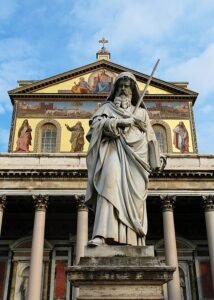
Here, Peter is referred to by his Aramaic name, Cephas, which means “rock”. The reference to the “pillars” of the Church suggests their stability, strength, and support for the gospel message and the community of believers. This title also reflects the respect and admiration that Saints Peter and Paul had for each other, despite their occasional disagreements and tensions, as they both recognized the primacy of Christ and the importance of unity and love in the Church.
The symbolism and significance of Saints Peter and Paul are manifold and rich. They represent different aspects of the Christian faith and mission, but together they form a powerful and inspiring witness to the truth and grace of Jesus Christ. Their lives and teachings continue to inspire and challenge us today, as we seek to follow in their footsteps and proclaim the good news to the world. Thank you for reading
What is so special about the Church of St. Peter?
The Church of St. Peter, also known as St. Peter’s Basilica, is one of the most important and significant churches in Christianity. It is located in Vatican City and is considered the mother church of Catholicism. The church was built on the site where St. Peter, the first Pope, was believed to have been buried after his martyrdom.
St. Peter’s Basilica is renowned for its stunning architecture, art, and history. The church is adorned with numerous priceless works of art, including Michelangelo’s famous sculpture of “Pieta,” which depicts the Virgin Mary holding the body of Jesus after the crucifixion. The interior of the church is awe-inspiring, with a massive dome, intricate mosaics, and ornate altars.
Many important events have taken place at St. Peter’s Basilica throughout history, including the coronation of Popes and the funerals of several prominent Catholic figures. It is a site of pilgrimage for millions of people from around the world every year, who come to pay their respects and seek spiritual solace.
Which church is the true church? The question of which church is the true church is a complex one and has been a subject of debate and disagreement for centuries. Christianity is divided into many different denominations, each with their own beliefs and practices.
However, it is generally accepted among Christians that the true church is not a physical building, but rather the body of believers who follow Jesus Christ and His teachings. This body of believers transcends denominational boundaries and includes all who have accepted Jesus as their Lord and Savior.
Saints Peter and Paul, who were both instrumental in the early Christian church, serve as role models for all Christians, regardless of denomination. Their teachings and examples continue to inspire and guide believers around the world, and their lives remind us of the importance of faith, perseverance, and commitment to the gospel.
While St. Peter’s Basilica is a significant and revered site in Catholicism, the true church is not a physical building or denomination, but rather the community of believers who follow Jesus Christ. The lives of Saints Peter and Paul serve as an inspiration to all Christians, and their legacies continue to influence and shape the church to this day.
How can I make a pilgrimage to Rome to see Saints Peter and Paul?
Making a pilgrimage to Rome to see Saints Peter and Paul is a unique and enriching experience that requires planning and preparation. To get started, you should consider working with a reputable travel agency that specializes in religious pilgrimages. These agencies can provide you with guidance and support as you plan your trip and can help you arrange accommodations, transportation, and tours.
When planning your pilgrimage to Rome, be sure to set aside enough time to visit the key sites associated with Saints Peter and Paul. The most important site is St. Peter’s Basilica, which is located in Vatican City. This stunning church is considered the mother church of Catholicism and is built on the site where St. Peter is believed to have been buried. Other important sites to visit include the Basilica of St. Paul Outside the Walls, which is built over the site where St. Paul is believed to have been buried, and the Catacombs of St. Callixtus, where many early Christians, including Saints Peter and Paul, were buried.
While in Rome, you may also want to participate in a Papal Audience, which is a weekly event held by the Pope in St. Peter’s Square. This is an opportunity to see the Pope in person and to receive his blessing.
What other Catholic things are there to see in Rome? Rome is rich in Catholic history and is home to many other important sites and landmarks that are worth visiting. Some of these include:
- The Sistine Chapel: Located in the Vatican Museums, the Sistine Chapel is home to some of the world’s most famous and awe-inspiring works of art, including Michelangelo’s stunning frescoes on the ceiling and walls.
- The Pantheon: This ancient Roman temple was converted into a Catholic church in the 7th century and is renowned for its impressive dome and stunning architecture.
- The Colosseum: While not a Catholic site per se, the Colosseum is a symbol of Rome’s rich history and is a must-see for anyone visiting the city. It is also worth noting that many early Christians were martyred in the Colosseum.
- The Spanish Steps: These iconic steps are located in the heart of Rome and are a popular spot for tourists and locals alike. They lead up to the Trinità dei Monti church, which offers stunning views of the city.
A pilgrimage to Rome to see Saints Peter and Paul can be a powerful and transformative experience. With careful planning and the guidance of a reputable travel agency, you can visit the key sites associated with these important saints and immerse yourself in the rich history and spirituality of Catholicism. Additionally, Rome is home to many other important Catholic sites and landmarks that are well worth visiting.
Making travel arrangements to see Saints Peter and Paul in Rome
Making travel arrangements to see Saints Peter and Paul in Rome is a wonderful idea for those who wish to explore the rich history and culture of the Catholic Church. While planning your trip to Rome, there are a few things you should consider to make the most out of your visit to the Eternal City.
- Choose the right time to visit: Rome can get quite crowded during the peak tourist season from June to August. If you prefer to avoid the crowds and enjoy a more relaxed trip, plan your visit during the shoulder season from April to May or September to October. Keep in mind that the weather can be unpredictable, so be sure to pack accordingly.
- Book your accommodation: Rome offers a range of accommodation options, from budget-friendly hostels to luxury hotels. It’s a good idea to book your accommodation in advance, especially if you’re planning to visit during the peak season. Consider staying in the vicinity of the Vatican or the historic center of Rome, as these areas offer easy access to many of the city’s major attractions.
- Plan your visit to the Vatican: The Vatican is home to some of the most important Catholic landmarks in the world, including St. Peter’s Basilica, the Sistine Chapel, and the Vatican Museums. Plan your visit in advance by purchasing skip-the-line tickets and booking a guided tour to make the most out of your visit.
- Visit other Catholic landmarks in Rome: While in Rome, don’t miss the opportunity to visit other important Catholic landmarks such as the Basilica of Santa Maria Maggiore, the Basilica of San Giovanni in Laterano, and the Catacombs of St. Callixtus.
- Explore the city’s cultural and culinary offerings: Rome is renowned for its art, architecture, and cuisine. Be sure to take the time to explore the city’s many museums, galleries, and markets, and indulge in some delicious Italian food and wine.
By following these tips, you can make the most out of your trip to Rome and enjoy a meaningful pilgrimage to the resting place of Saints Peter and Paul. Remember to take the time to soak in the history, culture, and spirituality of this amazing city, and create memories that will last a lifetime.
I believe that, as it has done for me, traveling will aid in your spiritual development.
Visiting the Vatican and the Holy Land on the footsteps of the last Korean saints before they were executed for their faith. When we comprehend our purpose and what God has in store for us, that is when our lives begin to change.
I’ve been all over the place. America, Scotland, Korea, Hong Kong, Macau, The Vatican, Switzerland, France, Milan, and all of Israel are among the countries I’ve visited. Soon, I’ll be in Turkey as well.
I am well-versed in all facets of travel. As a result, I’ve put up a list of concise resources to aid you in getting ready for your voyage.
- Find cheap flights for your journey HERE
- A Car Rental
- Taxi Drivers
- Bus or Train Tickets
- Choose the Perfect Hotel for Your Trip HERE
- Fun Events for Your Journey
- Travel Insurance
- Phone for Traveling
Time to pack your bags! 🙂
How can understanding who Saints Peter and Paul are help me to become a Saint?
Understanding who Saints Peter and Paul truly are to the Catholic Church can be a great source of inspiration for those seeking to grow in their faith and become saints themselves. These two apostles were not only instrumental in the formation of the early Church, but they also embodied the virtues and qualities that are essential to living a life of holiness.
- First and foremost, Saints Peter and Paul were deeply committed to their faith in Jesus Christ. They were willing to endure persecution and even martyrdom in order to bear witness to the truth of the Gospel. This unwavering faith can serve as a model for us as we strive to deepen our own faith and trust in God.
- Secondly, Saints Peter and Paul were both humble and repentant. Despite their status as leaders in the Church, they recognized their own weaknesses and faults and were quick to seek forgiveness from God and others. This humility and willingness to acknowledge one’s own shortcomings is an essential aspect of becoming a saint.
- Thirdly, Saints Peter and Paul were dedicated to the service of others. They worked tirelessly to spread the Good News of the Gospel and to build up the Church. Their selflessness and commitment to the needs of others can inspire us to put the needs of others before our own and to live lives of service and generosity.
By understanding the example of Saints Peter and Paul, we can learn valuable lessons on how to grow in holiness and become saints ourselves. We can cultivate a deeper faith in God, a humble and repentant heart, and a commitment to the service of others. Through the grace of God and our own efforts, we too can become shining examples of holiness and virtue, just like Saints Peter and Paul.
Are You Inspired?
Did today’s lessons on Saints Peter and Paul inspire you in any way? The lives of the saints are so interesting to read about and discuss. It has a great chance of producing spiritual fruit in our lives.
Would you like a simple and easy way to bring up what you’ve just learned about Saints Peter and Paul with your friends and family?
You won’t have any trouble explaining the significance of Saints Peter and Paul if you’re wearing the gorgeous shirt I prepared just for you.
Wearing these t-shirts makes it fun to talk about saints with close friends, family, and complete strangers. You can now tell anyone who asks what your shirt says all about Saints Peter and Paul and how important they have been to the development of Christianity.
They could even agree to accompany you to church. Even better, you might be able to introduce them to the Gospel, which will aid in their salvation from sin. All people have sinned and fallen short of God’s glory, according to Romans 3:23. Thus, everyone requires a Savior. This should be something you can explain to them.
God sent His one and only son to live under the law in order to redeem those who were under the law so that we could become His children. Romans 4:15–16
In order to atone for our sins, Jesus had to travel to Earth, go through hell, and ultimately die. according to the Bible
“Indeed, under the law almost everything is purified with blood, and without the shedding of blood there is no forgiveness of sins.”
– Hebrews 9:22
Family, friends, and acquaintances can become members of a nearby church through the Rite of Christian Initiation for Adults (RCIA). By taking part in RCIA programs offered by their parish, students can learn everything they need to know about our magnificent Christian religion and our Compassionate Jesus.
To view the shirt design for Saints Peter and Paul, simply click the image or CLICK HERE. The BUY NOW button will lead you to the checkout page after you select your preferred size and color.

For more great saints, visit our blog HERE.
Have a few more minutes to dive into another saint?
Why not learn about:
- St. Joan of Arc – Unleash Your Inner Warrior: 21 Inspiring Facts of the Story of Her Life
- Awaken Your Soul with the Sacred Heart of Jesus: 15 Facts to Embrace His Love and Find True Peace
- 11 Facts of the Unforgettable Story of Boniface Saint: From Humble Beginnings to Heavenly Glory
- Feast Corpus Christi: Experience the Divine -14 Facts on this Most Holy Celebration
Have you considered about coming back every day to read more about the Saint of the Day after being motivated by learning about Saints Peter and Paul? If you’d like to receive my daily saint emails in your inbox, kindly take a moment to join up. I’ll make it brief since I know you have a lot on your plate, but I’ll say more because I want you to gain wisdom from me and grow as a saint every day.
In addition, I’ll give you a free screensaver for your phone. As soon as you submit the form, I’ll email you a link to download the screensaver. Enjoy!
Thank you so much for reading about my post on Saints Peter and Paul and taking the time to learn more. Now, that you understand more about Saints Peter and Paul, you have a better understanding of not only these incredible saints but also the history of the Catholic church as well. I will pray that you will encounter God’s will for your life.
I guess that’s everything for today.
Tomorrow, I’ll be back with another Saint of the Day to encourage you.
God bless you,
-Priscilla



